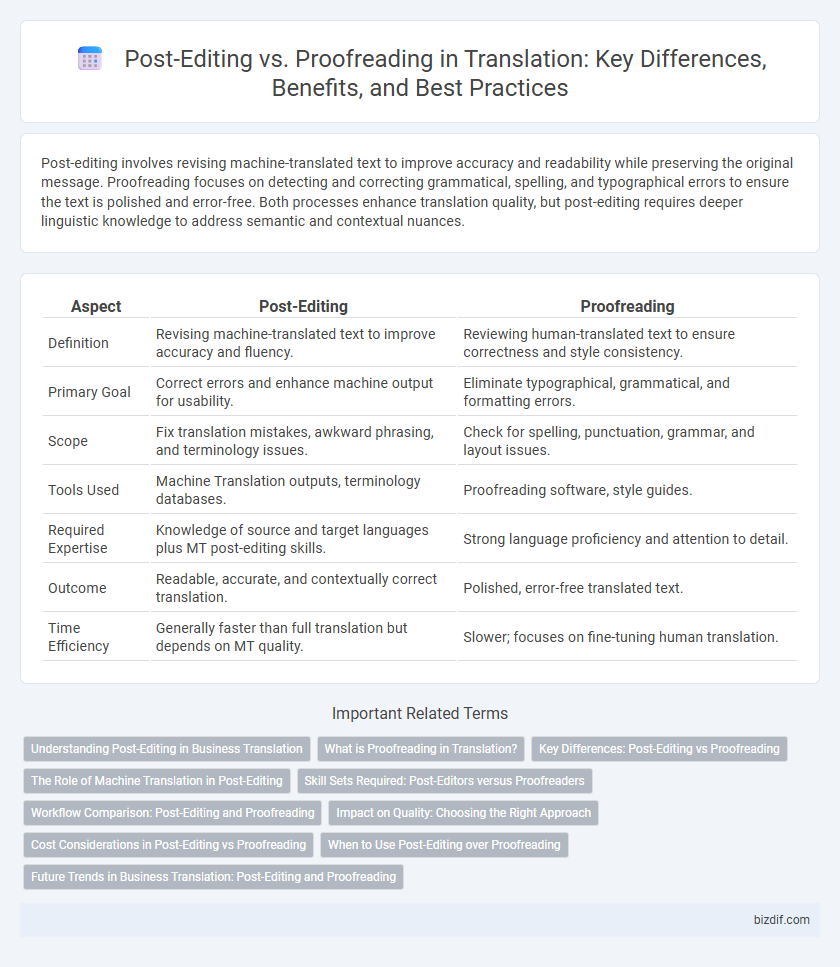Post-editing involves revising machine-translated text to improve accuracy and readability while preserving the original message. Proofreading focuses on detecting and correcting grammatical, spelling, and typographical errors to ensure the text is polished and error-free. Both processes enhance translation quality, but post-editing requires deeper linguistic knowledge to address semantic and contextual nuances.
Table of Comparison
| Aspect | Post-Editing | Proofreading |
|---|---|---|
| Definition | Revising machine-translated text to improve accuracy and fluency. | Reviewing human-translated text to ensure correctness and style consistency. |
| Primary Goal | Correct errors and enhance machine output for usability. | Eliminate typographical, grammatical, and formatting errors. |
| Scope | Fix translation mistakes, awkward phrasing, and terminology issues. | Check for spelling, punctuation, grammar, and layout issues. |
| Tools Used | Machine Translation outputs, terminology databases. | Proofreading software, style guides. |
| Required Expertise | Knowledge of source and target languages plus MT post-editing skills. | Strong language proficiency and attention to detail. |
| Outcome | Readable, accurate, and contextually correct translation. | Polished, error-free translated text. |
| Time Efficiency | Generally faster than full translation but depends on MT quality. | Slower; focuses on fine-tuning human translation. |
Understanding Post-Editing in Business Translation
Understanding post-editing in business translation involves refining machine-translated content to meet professional standards, ensuring accuracy, clarity, and cultural relevance. This process reduces turnaround time and lowers costs compared to traditional translation, while maintaining quality essential for corporate communications and marketing materials. Effective post-editing demands skilled linguists familiar with industry-specific terminology, enhancing the final output for global business audiences.
What is Proofreading in Translation?
Proofreading in translation involves carefully reviewing the translated text to identify and correct errors in grammar, spelling, punctuation, and formatting while ensuring consistency with the source content. It focuses on polishing the final translated document to enhance readability and accuracy without altering the original meaning. This step is crucial for maintaining high-quality translations and delivering a flawless end product.
Key Differences: Post-Editing vs Proofreading
Post-editing involves revising machine-translated content to ensure accuracy, clarity, and natural language flow, while proofreading focuses on detecting and correcting grammatical, spelling, and punctuation errors in the final text. Post-editing often requires a deep understanding of the source language and context to handle machine translation inconsistencies, whereas proofreading typically deals with polished human-translated or original content. The key difference lies in post-editing improving both linguistic and contextual quality, whereas proofreading primarily ensures textual correctness.
The Role of Machine Translation in Post-Editing
Machine Translation plays a crucial role in post-editing by generating initial translations that human editors refine for accuracy and fluency. Post-editing leverages Machine Translation outputs to improve translation speed and reduce costs compared to traditional proofreading, which involves checking already-human-translated text for errors. The effectiveness of post-editing depends on the quality of the Machine Translation engine and the expertise of the post-editor in detecting and correcting nuances and context-specific issues.
Skill Sets Required: Post-Editors versus Proofreaders
Post-editors require strong bilingual proficiency combined with advanced translation software skills, enabling efficient correction of machine-translated texts while maintaining contextual accuracy. Proofreaders, on the other hand, must possess exceptional attention to detail, deep knowledge of grammar, syntax, and style guides to ensure flawless final text quality. Both roles demand critical language expertise but differ in technical familiarity and intervention depth in the translation workflow.
Workflow Comparison: Post-Editing and Proofreading
Post-editing involves revising machine-translated content to ensure accuracy, fluency, and context relevance, typically requiring specialized linguistic skills and subject matter expertise. Proofreading focuses on identifying and correcting grammatical, typographical, and formatting errors in human-translated text, emphasizing surface-level quality checks. The workflow for post-editing integrates machine translation outputs early, speeding up production, while proofreading occurs at the final stage to ensure polished, error-free deliverables.
Impact on Quality: Choosing the Right Approach
Post-editing enhances translation quality by refining machine-generated drafts, improving accuracy, consistency, and fluency while maintaining terminological precision. Proofreading primarily focuses on identifying surface-level errors such as typos, grammatical mistakes, and formatting issues, ensuring a polished final text without altering core content. Selecting post-editing or proofreading depends on the initial text quality and project goals, with post-editing suited for machine translations and proofreading ideal for human-translated texts.
Cost Considerations in Post-Editing vs Proofreading
Post-editing generally incurs higher costs than proofreading due to the extensive time required to correct and adapt machine-translated content for accuracy and fluency. Proofreading typically involves a less intensive review focused on catching minor errors and ensuring consistency, resulting in lower hourly rates and faster turnaround times. Organizations must weigh the initial investment in post-editing against long-term gains in translation quality and scalability.
When to Use Post-Editing over Proofreading
Post-editing is essential when machine-translated content requires substantial revision to enhance accuracy and naturalness, especially in technical or specialized texts. It is preferred over proofreading when the initial translation may contain errors or unnatural phrasing that automated tools cannot fully resolve. Use post-editing to improve clarity, terminology consistency, and contextual relevance before finalizing translations for professional use.
Future Trends in Business Translation: Post-Editing and Proofreading
Post-editing and proofreading are evolving as critical components in future business translation workflows, integrating AI-driven machine translation with human expertise to enhance accuracy and efficiency. Advanced neural machine translation systems reduce initial errors, allowing post-editors to focus on nuanced linguistic adjustments while proofreaders ensure final quality control aligned with brand tone and regulatory compliance. Investment in post-editing tools and continuous training is projected to increase, reflecting a shift towards hybrid translation models that balance speed, cost-effectiveness, and high-quality output in global business communication.
Post-Editing vs Proofreading Infographic

 bizdif.com
bizdif.com